Courage, humility, and the Mennonite Arts Weekend
![]()
____________

There is a little, urban church in southwestern Ohio that creates a magical thing every even-numbered year. The Mennonite Arts Weekend takes place in Cincinnati, and the year 2020 will see MAW’s fifteenth gathering of Mennonite visual, musical, and prose/poetry artists. Even though the church is graced by commissioned artwork from MAW artists, the little church itself is too small for the crowds; thus, a much larger church, Pleasant Ridge Presbyterian, kindly hosts the event. The Mennonite Arts Weekend is held every even numbered year, on the first weekend in February. Registration is open to the public.
Hal Hess is the director of the Mennonite Arts Weekend. Recently, we sat on his covered porch, looked out at his gardens, and talked about courage, humility, and the Mennonite Arts Weekend (MAW.) The following are notes from that conversation and from various interviews and papers, which I have listed below as resources. This post includes pictures of some of the artwork, musicians, writers, and participants.

2014, Marilyn Houser Hamm, and The Steel Wheels
The courage to start:
Traditionally, art was not welcome in more conservative Mennonite churches. Hymn singing and functional arts such as furniture and quilt making were acceptable, but showing off one’s artwork was hochmütig (prideful.) Creatives felt cast out, and the church began to lose its artists to a larger world that gladly accepted beauty beyond simple functionality. In 1989, though, at a Mennonite Conference in Illinois, artists demanded a seat at the table.
An outreach committee at Cincinnati Mennonite Fellowship responded to this call, and the first Mennonite Arts Weekend was held in 1992. Now well established, it continues to nurture community among artists and audiences. This year, 2018, artist-presenters included: the Theatre of the Beat, Fantasy writer and poet, Sofia Samatar, cellist Eugene Friesen, Painter Paul Buxman, artist/illustrator/designer Karen Newe, painter/printmaker Brenton Good, Conductor/song leader Jim Heiks, poet Becca J.R. Lachman, singer/songwriter Sadie Gustafson-Zook and worship planners Sarah Kathleen Johnson and Carl Bear.
Anyone who has seen the work of Hal Hess and his committee knows that the success of the Weekend has happened because of intense dedication. Two years of conceptualizing preceded the first weekend: structural, worship, and facility concerns were painstakingly considered.
In the early 1990s, Cincinnati Mennonite Fellowship met in the educational wing of a larger church near the University of Cincinnati. How could the ed. wing be made welcoming? There was no money to give the visual, poetry/prose, and musical artists who were asked to come. Might they come if asked, and would an audience come to a non-Mennonite church for the festivities? Hal credits Cheryl Pannabecker, the first director, for steady and strong leadership in the earliest years.
So, who came that first weekend? All the presenters and over 60 people!
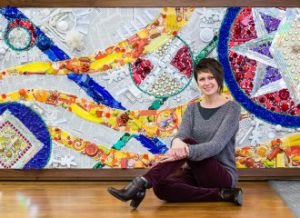
Commissioned artwork, Kris Shenk, MAW 2016
My husband and I, members of the original Cincinnati fellowship in 1975, which was an effort by rural Mennonites to develop relationships within cities, soon had to leave for jobs further from the city. We came back in 1996 and were blessed to attend the Mennonite Arts Weekend. The warmth of community, sharing, and beauty made further weekends a must-attend for us.
The courage to continue:
Hal Hess tells of a phone call in which poet Julia Kasdorf helped him decide that paying the artists was a necessity, not a nicety. A thank you and a handshake were simply not enough, he says. Honoring the artists meant providing stipends, transportation, and lodging. The process has been a learning experience.
We had to raise money and balance the budget. Part of our journey was learning not to ask Mennonites throughout the country for long-term money to establish a financial base (general fund)—so that we could draw from that for commissions and to cover ourselves if expenses exceeded income—then have to go back and ask for specific money for the weekend itself. That painful situation happened one time only!
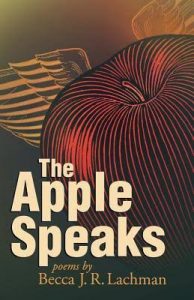
As the arts weekend has grown, courage has been required of the committee to approach churches and schools, asking them not only for use of their facilities but also to allow a (joint) Mennonite Sunday service. Hal has had to ask larger churches of other denominations to trust the Mennonites not to proselytize—which does sound familiar to the descendants of European Anabaptists who were allowed to find refuge in hoots and hollows in exchange for good farming and keeping their beliefs to themselves. Promising to have enough volunteers for hauling, handling, and taking down exhibits, assembling and manning registration, working tech, and making snacks (although the event is now catered) has meant asking Cincinnati Mennonite Fellowship members to give time and muscle to the event. The fellowship has done so willingly, but the MAW committee must show the courage of their convictions by asking each year.
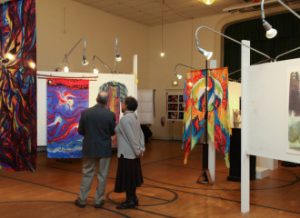
Viewing the art show; commissioned silk gonfalon by Juanita Yoder
The humility of success:
It seems the human condition: work as if you were responsible for the whole thing, but recognize that other forces are in play. That first year, the six of us committee members were not guaranteed success, but by the end of the weekend, we had enough to pay our bills, Hal says. With all the work the committee put into every part of the event, they wondered at, and thanked the powers that had intervened to help them. Hal fully understands the effort that goes into the weekend, but says it is humbling to see it happen.
‘Transformation: Reseeing, Reshaping, Renewing,’ ‘Touching Mystery,’ and ‘The Power of Story’ have been a few of the subjects explored by the artists.

The humility of the presenters themselves:
Hess gives one example (of many) of the humility of those who present at the Mennonite Arts Weekend. For the 2018 event, Hal wanted to invite the four-time Grammy winning cellist, Eugene Friesen, who has worked and recorded with such diverse artists as Dave Brubeck, Toots Thielemans, Betty Buckley, Will Ackerman, Joe Lovano and Dream Theater, and has been featured in concerts all over the world. Hal wasn’t sure that the cellist would want to give MAW his time. Days of trying different phone numbers did lead to contact. After an intermediary’s ‘Hello? Yes, I’ll get him,’ the phone was answered by a man who said, ‘How did you get this number?’ Friesen was in a classroom at a university. Hal plowed ahead with his invitation, and to his surprise the cellist said that he would come. It is important to know that Hal Hess himself is a fine tenor with his own résumé of successes, and that he is not a shrinking violet. Still, Friesen’s acquiescence was a pleasant surprise.
Every artist at MAW must accept that on Saturday, groups of three presenters give their lectures, art shows and musical demonstrations simultaneously. One artist presents, while two other artists exhibit. Registrants can decide whom to see during that 75-minute time. This workshop structure is an integral part of the weekend. Friesen accepted the structure with equanimity.
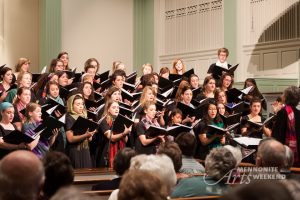
2012, Goshen College Women’s World Music Choir
Later, at a meal, Hal noticed Friesen asking strangers about their lives. A plethora of similar stories can be told about the Weekend’s presenters. Of course, appearing proud is frowned upon by the Mennonite culture, but Mennonites are human and must wrestle with the angels of egotism anyway. Hal Hess and the MAW committee are grateful for the many creatives who have graced the Weekend with their generosity and flexibility. Each presenter embodies the Anabaptist principles of peace, justice, and responsibility.
From a church ed. wing, to a school, then a Unitarian church, and finally its present home in the Cincinnati neighborhood of Pleasant Ridge, the Mennonite Arts Weekend has grown from its original 60+ people to a consistent registration of over 200. Staples of the Weekend are: a Friday evening performance, Saturday workshops and hymn sing, Saturday evening’s concert, and an artistic Sunday service held jointly with the Presbyterians.
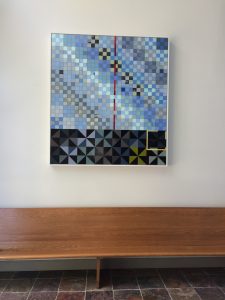
Commissioned painting, 2018, by Brenton Good
At each event, my husband and I have made a happy habit of buying artwork, books, and performer’s CDs. We cherish them for their celebration of creatives, gently prodding the Mennonite and Anabaptist traditions of simplicity and humility toward not only acceptance but awe.
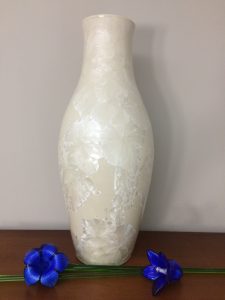
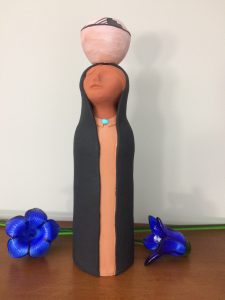
Some of the MAW artwork in our home: vase by Eric Kaufmann; clay figurine by Mary Alice Mitchell-Trejo
____________
Enjoy two talented young muscians!
____________
The following podcast, an interview of Hal Hess by Lee Hay from WVXU on January 12, 2018 explains more about the Mennonite Arts Weekend.
Other sources:
Cincinnati Mennonite Arts Weekend
____________
I welcome your comments: gretaholtwriter.com/blog.
{Thank you to my niece, Addie Liechty, for taking the picture above that is this blog’s featured image. Her blog is: https://addieswriting.wordpress.com.}
Best wishes and have a good week.
Greta
I anticipate the Arts Weekend in Cincinnati from year to year. Thanks for posting all this info. I wanted to share it on Facebook but didn’t see how to do it. Anyone interested in the arts would enjoy this event.
Agreed. You can to to MAW’s FB page, copy it, and post to your timeline. Thanks, Ruth!
Fun to see what you are excited about Greta! Great article and pictures.
I love the art you showed from your collection. I am learning about Mennonites
from you!
Thanks, Nicky. We’re a little different from what folks expect. 😊
Greta, what a wonderful show that must be! Like Nicky, I am learning so much about the Mennonites from your posts, and I’m very grateful for that!
Thanks, Diane. As the 2001 Mennonite Church USA breaks into conservative and liberal factions (over hierarchy and LGBTQ inclusion,) we must re-define our faith, social response, and politics.